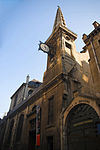Hôtel Hesselin
1642 establishments in FranceAncien Régime French architectureBuildings and structures demolished in 1835Buildings and structures in the 4th arrondissement of ParisDemolished buildings and structures in Paris ... and 3 more
Former buildings and structures in ParisHouses completed in 1642Hôtels particuliers in Paris

The Hôtel Hesselin, later known as the Hôtel d'Ambrun, was a Parisian town house (hôtel particulier), erected around 1639 to 1642 for Louis Hesselin to the designs of the French architect Louis Le Vau. It was located on the Île Saint-Louis, on the west side of the rue Poulletier at its intersection with the quai du Dauphin (now 24 quai de Béthune, 4th arrondissement of Paris). The hotel was demolished in 1935 by Helena Rubinstein, who had a new building erected to the designs of the architect Louis Sue.
Excerpt from the Wikipedia article Hôtel Hesselin (License: CC BY-SA 3.0, Authors, Images).Hôtel Hesselin
Quai de Béthune, Paris 4th Arrondissement (Paris)
Geographical coordinates (GPS) Address Nearby Places Show on map
Geographical coordinates (GPS)
| Latitude | Longitude |
|---|---|
| N 48.850782 ° | E 2.3574 ° |
Address
Quai de Béthune 24
75004 Paris, 4th Arrondissement (Paris)
Ile-de-France, France
Open on Google Maps










